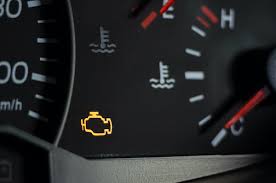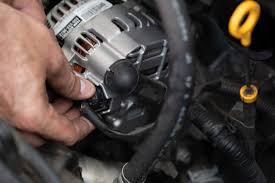What Does It Mean When Your Check Engine Light Is Blinking?

Seeing your check engine light blinking can be alarming. Unlike a solid light, a blinking check engine light often indicates a more severe issue that requires immediate attention. In this blog, we’ll explore what a blinking check engine light means, the potential causes, and what steps to take to address it.
What Is the Check Engine Light?
The check engine light is part of your car’s onboard diagnostic system (OBD). It serves as a warning system, alerting you to potential issues with your vehicle’s engine, emissions system, or other critical components. A blinking light typically signifies a serious problem compared to a steady light.
Why Is Your Check Engine Light Blinking?
A blinking check engine light usually indicates a misfire in the engine, which can lead to unburned fuel entering the exhaust system. This can cause damage to the catalytic converter and other parts of your vehicle. Ignoring it may result in costly repairs or even safety risks.
Common Causes of a Blinking Check Engine Light
Here are the most common reasons why your check engine light might be blinking:
1. Engine Misfire
- Description: A misfire occurs when one or more cylinders fail to ignite the air-fuel mixture properly.
- Symptoms: Rough idling, poor acceleration, and reduced fuel efficiency.
2. Faulty Spark Plugs or Ignition Coils
- Description: Worn-out spark plugs or failing ignition coils can prevent proper combustion.
- Symptoms: Engine hesitation, difficulty starting, and loss of power.
3. Clogged or Failing Catalytic Converter
- Description: A clogged catalytic converter can’t efficiently process exhaust gases, leading to increased emissions.
- Symptoms: Reduced engine performance and a sulfur-like smell from the exhaust.
4. Bad Fuel Injectors
- Description: Faulty or clogged fuel injectors can disrupt the fuel supply to the engine.
- Symptoms: Stalling, rough running, and reduced fuel economy.
5. Low or Contaminated Fuel
- Description: Poor-quality or insufficient fuel can cause the engine to misfire.
- Symptoms: Engine sputtering and a blinking check engine light immediately after refueling.
6. Vacuum Leaks
- Description: A leak in the vacuum system can disrupt the air-fuel mixture balance.
- Symptoms: High idle speeds and inconsistent engine performance.
What to Do When Your Check Engine Light Is Blinking
1. Reduce Driving Speed
A blinking check engine light signals a critical issue. Slow down and drive carefully to minimize engine strain.
2. Pull Over Safely
If the light continues to blink, pull over as soon as it’s safe to do so. Continuing to drive could lead to severe damage.
3. Check for Obvious Issues
Inspect your vehicle for visible problems, such as:
- Loose or damaged spark plug wires.
- Signs of overheating (e.g., steam from the engine).
- Low oil or coolant levels.
4. Get a Diagnostic Scan
Use an OBD-II scanner to retrieve error codes from the onboard diagnostic system. These codes can pinpoint the issue.
5. Visit a Mechanic
If you don’t have the tools or expertise to diagnose the issue, take your car to a professional mechanic. Provide them with the error codes for a quicker diagnosis.
Can You Drive With a Blinking Check Engine Light?
It’s not advisable to drive with a blinking check engine light. Doing so could worsen the problem and lead to costly repairs, such as replacing the catalytic converter or engine components. If you must drive, keep it to a minimum and avoid high speeds or heavy acceleration.
Preventing Future Check Engine Light Issues
1. Regular Maintenance
Keep up with routine maintenance, such as oil changes, spark plug replacements, and air filter changes.
2. Use Quality Fuel
Always fill up with high-quality fuel to prevent contamination and misfires.
3. Address Small Issues Quickly
Don’t ignore minor problems, like a rough idle or occasional misfire. Small issues can escalate into larger, more expensive repairs.
4. Monitor Warning Signs
Pay attention to other warning lights and unusual sounds or smells from your vehicle.
Frequently Asked Questions
1. Is a blinking check engine light an emergency?
Yes, a blinking check engine light typically indicates a severe issue, such as an engine misfire or risk of catalytic converter damage. Address it immediately.
2. Can low oil cause the check engine light to blink?
Low oil levels alone may not cause the light to blink, but they can lead to engine problems that trigger the light. Always ensure your oil level is adequate.
3. How much does it cost to fix a blinking check engine light?
Costs vary depending on the issue. Minor fixes, like replacing spark plugs, can cost around $100–$200. Major repairs, such as catalytic converter replacement, may cost $1,000 or more.
4. Can I reset the check engine light myself?
You can reset the light using an OBD-II scanner, but this won’t fix the underlying problem. Ensure the issue is resolved before resetting.
5. Will disconnecting the battery reset the check engine light?
Yes, disconnecting the battery can reset the light, but it’s a temporary solution that doesn’t address the cause.
Conclusion
A blinking check engine light is not something to take lightly. It often signals a serious issue, such as an engine misfire or catalytic converter problem. By understanding the possible causes and taking prompt action, you can minimize damage and repair costs. Regular maintenance and monitoring your vehicle’s performance are key to preventing these issues in the future.
When in doubt, consult a professional mechanic to ensure your car is safe to drive and the problem is properly resolved.
Also Check:
• How to Tell If Your Oxygen (O2) Sensor Is Bad






One Comment